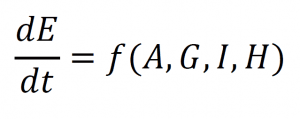Doi.org/10.1177/2053019616688022
Target Article
Gaffney, O., and Steffen, W., (2017) The Anthropocene Equation, The Anthropocene Review, 4:53-61 Available at: http://journals.sagepub.com/doi/full/10.1177/2053019616688022 DOI: 10.1177/2053019616688022
Significant Claim and Possible caveat with this article
This paper claims to represent the disruption of the climate system by humans in the form of a mathematical equation and then warns that the climate could reach a totally new, dangerous equilibrium point, very different from any climate that the earth has ever experienced in the past. The authors claim to prove that all non-human effects on the “earth system” add to zero, i.e, there are presently no natural fluctuations in climate. It is concluded that the human-induced changes to the biosphere are likely to be discernible on earth for millions of years.
The predictions of the article are based on what is termed the “anthropogenic equation” (See Eq. 1),
where A is the astronomical forcings, G is the geophysical forcings, and I is the internal dynamics of the Earth System (which are considered to tend to zero). H is the human activity calculated with H = f(P,C,T) , and T = f (En, K, Pe). All of the variables represent nebulous ideas such as “P = political economy” “T = Technosphere” and “K = Knowledge”. These symbols may give the impression that this is mathematics, but these quantities are not measured and in most cases are unmeasurable. It is therefore, impossible to substitute numerical values (with any meaning) into this formula, and thus, the formula is not usable in any way to make predictions. Clearly, the authors aim to provide an impression of sophistication and precision; however, this equation is not useful as a predictive tool in any way. It does not show any empirical relationship through real data (e.g., evaporation from water surface by Penman 1948[1]), nor a theory used to derive this equation (e.g., the Euler’s function discussed by Lehmer, 1932[2]).
Where maths is used to model natural or human-made systems, the variables in the equations must represent some measurable quantity which will have a tangible unit of measurement. Physicists, for example, will measure mass in kilograms, and energy in Joules and the energy required to create a mass m is given by the equation E = mc^2 where c is the speed of light (measured in meters per second). Engineers and economists will use maths in a similar way and variables will always represent real measurable quantities. Examples would be the tensile strength of steel (measured in Pascals) or the value of the national GDP (measured in $).
By contrast, the single equation in this paper might not be using measurable variables, and this equation does not provide a solution which readers could use for further investigation. If Equation 1 is not explicitly expressed for validation, the level uncertainties from Equation 1 are not available to be assessed.
In addition, the functions, given by the symbols f(x) are not explicitly stipulated so there is no detail of the functionality. In the case of E = mc^2 the function is specifically to take mass and multiply by the speed of light squared. If we used the same approach as this paper, we would write Einstein’s well-known relationship as E = f(m,c) which means that energy is related to mass and the speed of light, but that we do not stipulate what this relationship is. This may not useful, and could not be applied to make any prediction or calculation. Unlike E = mc^2, which can be checked by measurement and has survived the test of time, the “anthropogenic equation” might not be checked because none of the variables are measurable, and the functionality between the variables is unspecified. Additionally, a dimensional analysis which is needed when proposing a new formulation is not assessed and provided in this paper, therefore, it is hard to know if feeding oranges into this "equation" can provide you apples as a result. One could wonder if a more appropriate name would be "philosophical implicit proposed relationship" instead of equation, but such new name may not yet exist.
References
- ↑ * [1] Penman, H.L., (1948) Natural Evaporation from Open Water, Bare Soil and Grass, Proceedings of the Royal Society of London, 193:120–145, doi: 10.1098/rspa.1948.0037
- ↑ * [2] Lehmer, D.H., (1932) On Euler’s totient function, Bull. Amer. Math. Soc., 38:745–751, doi: 10.1090/s0002-9904-1932-05521-5
Comments
In WL-Letters you have the freedom to respond to any caveat that may be inaccurate.
-- Andutta (talk) 18:11, 6 July 2022 (UTC)
